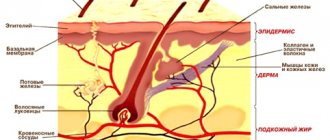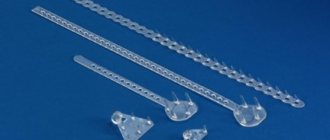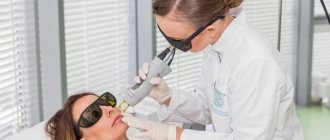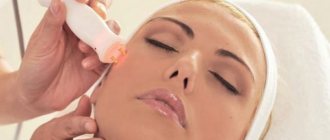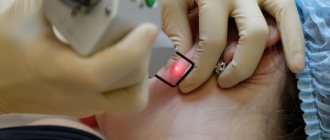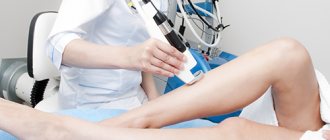To protect beauty, all means are good, and modern technologies will help preserve youth for a long time. To rejuvenate the face, many techniques have been invented to get rid of numerous defects in the form of post-acne, scars and wrinkles in cosmetology using an erbium laser, which, while eliminating them, also rejuvenates the skin.
What is an erbium laser
It heats the skin with its beam, under the influence of high temperatures, its upper layer seems to evaporate, and dead cells are removed along with it. This process triggers the regeneration of new cells and their intensive renewal. The skin renews itself faster and collagen is produced in its layers.
The video below will tell you what an erbium laser is:
Concept and essence
The effect of an erbium laser is equivalent to a thermomechanical effect on the skin. This laser has a wavelength of 2940 nanometers, which corresponds to the absorption spectrum of water.
The laser exposure time on the skin is short and therefore has a mild effect on the skin. In this case, under the influence of laser energy, the water contained in the skin passes into a vapor or liquid state. The liquid in the epidermis expands very quickly and creates high pressure, under the influence of which excess tissue is expelled from the depths of the skin; this principle applies to both hard and soft tissues. In those places where laser treatment occurred, the cellular fluid evaporates and the production of new cells and collagen is stimulated.
The high speed of laser action makes it possible for it to penetrate only into the upper layers of the epidermis, without affecting the deeper ones, which is why the laser is called “cold”. This makes it possible to carry out laser resurfacing not only of the face and neck, but also the area around the eyes and mouth, and the back of the hands. The procedure has a tightening effect and its results last for six months.
Erbium laser (before and after photos)
Types of procedure
Erbium laser is not only used for resurfacing, but also used for fractional photothermolysis. The principle of this technique is based on the impact of the laser on small areas of the skin, they are microscopic, their size is no more than the diameter of a hair. There are many such zones on every square centimeter of skin; there can be either 100 or 11 thousand of them.
The beam penetration is about 1.5 microns, it is at this level that wrinkles form; after the destruction of damaged fibers, new collagen and elastin tissues quickly form in their places.
This fractional impact is much better than conventional grinding; after it, more effective results are achieved and all signs of aging are removed.
Comparison with similar techniques
The erbium laser gives a facelift that is comparable to the use of a CO2 laser. Unlike similar techniques, this laser removes only a thin layer of skin, which allows you to control the procedure at all stages. A low-energy laser destroys only the upper layers of the skin, while healthy tissue located deeper is not affected. With this technique there are no complications in the form of scars and hyperpigmentation.
Previously, chemical peeling was used to stimulate new cells and remove their dead counterparts, which sometimes resulted in unpleasant consequences. The erbium laser has now become an excellent analogue of this technique.
Advantages of the technique
Erbium laser in cosmetology is considered one of the most delicate methods of treatment. Due to its short wavelength (2.94 µm), it has the ability to penetrate pointwise and does not affect adjacent soft tissue. Compared to other types of laser, erbium laser acts as gently as possible, penetrating to a depth of 5 microns, being completely absorbed in tissues. This property allows you to control the effect on the skin and reduce the risks of possible complications.
It should also be noted that laser skin resurfacing using an erbium laser is tolerated quite easily by most patients, and often does not even require local anesthesia. The fact is that the treatment is carried out in areas that do not have nerve endings, and the small thickness of the heated skin allows the temperature to quickly drop without causing discomfort to the person. The delicacy of the effect allows you to work with the most sensitive areas of the skin located around the mouth or eyes.
The algorithm of action described above is relevant for laser skin resurfacing; however, a laser with erbium particles is also used for the recently popular fractional photothermolysis. The main difference of this procedure is that the problem area is exposed not to one extensive pulse of light, but to a beam divided into separate fractions with a diameter of no more than a millimeter. The purpose of photothermolysis is to destroy damaged cells and collagen, stimulating their replacement with new healthy fibers.
Indications
When performing laser resurfacing, everything happens in comfortable conditions and is absolutely safe, there is no pain, but a slight burning sensation may be felt.
This procedure is used by those who have the following problems:
- sagging skin is clearly visible;
- there are small wrinkles around the mouth, eyes and forehead;
- there are depressions that remain from old acne;
- there are stretch marks on the body;
- small tattoos, age spots and birthmarks;
- cholesterol plaques, scars or papillomas;
- small shallow scars;
- wrinkles above the lip;
- moderately expressed keratosis;
- decreased skin elasticity;
- clogged greasy blinds;
- low skin blood circulation.
After exposure to an erbium laser, the activity of the sebaceous glands is normalized, rapid cell renewal occurs, and the skin type changes from dry to normal.
Erbium laser (scar removal)
Application of laser in cosmetology
The concept of aesthetic medicine includes a wide range of services provided to modern people today. This is a complex of the latest developments and techniques for correcting and eliminating appearance defects, which includes:
- elimination of age-related changes;
- correction of imperfections in the skin of the face and body;
- laser cosmetology;
- phototherapy;
- elimination of facial wrinkles;
- hardware cosmetology.
Humanity has been concerned with the problem of facial skin rejuvenation for many millennia. People have always tried to achieve unfading beauty and youth with the help of various cosmetics. Nowadays, equipment has come to the aid of numerous creams and masks, which have become widely used not only in medicine, but also in cosmetology, which is closely related to aesthetic medicine.
This industry involves the use of expensive equipment, technologies, tools and medicines. Before starting work, highly qualified specialists regularly take courses and improve their knowledge, mastering more and more new devices. Therefore, the use of techniques such as laser cosmetology using an erbium laser costs certain costs.
Contraindications
Among the reasons why an erbium laser cannot be used are:
- pregnancy period;
- autoimmune diseases;
- period of exacerbation of chronic diseases;
- unstable mental state, epilepsy;
- the presence of neoplasms and inflammation in the treated areas;
- problems with blood clotting;
- diabetes type 1 or 2;
- predisposition to scars;
- poor healing of wounds;
- thyroid problems;
- varicose veins in the treated areas.
There are other individual contraindications that can only be determined by a doctor. The technique helps eliminate various skin problems in both middle-aged people and young people.
Laser resurfacing
A multifunctional procedure, also called laser peeling or dermabrasion. According to indications, sessions are carried out with different voltages and depths of exposure to the laser beam. The goal is to eliminate damaged skin cells, fill their layers with nutrients and oxygen, and stimulate recovery processes.
Before starting the procedure, it is necessary to carry out a superficial peeling and be examined (pass the necessary tests) to avoid unwanted complications. Then, under local anesthesia, the face is resurfaced with an erbium laser. At the end of the procedure, a mask with sedatives is applied to the affected areas. This technique allows you to get rid of skin defects in a short period of time. The procedure takes about 40 minutes, depending on the area of the surface being treated.
When removing the top layer of skin, the laser triggers the mechanism of dermal cell renewal and collagen production, improving tone. Flabbiness is replaced by freshness and elasticity.
And since the restoration of the skin occurs gradually, the final result can be enjoyed in 4-6 months. The rejuvenation effect achieved using this method is quite lasting, about 5 years.
Good results are obtained when using a laser to get rid of wrinkles, stretch marks, and high pigmentation. You can use this method in the fight against warts. The procedure is effective and a high level of safety is maintained during its implementation.
Using an erbium laser in cosmetology, you can eliminate defects such as:
- benign neoplasms (certain types of moles, papillomas, warts);
- wrinkles and the consequences of acne;
- scars after injuries and burns;
- tattoos and pigmentation;
- stretch marks.
The need for preliminary preparation and the number of procedures is determined by the doctor in each specific case after an individual consultation.
Carrying out
The procedure can only be performed by an experienced cosmetologist or dermatologist who has the appropriate certificates for completing courses in the use of erbium lasers.
The video below will tell you how the procedure is carried out:
Preparation
It is not particularly required, in some cases it is necessary to moisturize the skin, it is advisable to carry out peeling, it is better to give preference to the ultrasonic type. If a girl is taking contraceptives, then their course should be interrupted, and if a person is infected with herpes, then she should first take antiviral drugs.
Algorithm
- The duration of the procedure can last from half an hour to 1.5 hours, this is influenced by the number of defects in the treated areas and the skin’s ability to regenerate. Up to 5 procedures may be needed to achieve the desired effect.
- To carry out the procedure, a fractional laser is used, which has a gentle effect on the skin, while coagulation of blood vessels is eliminated.
- After exposure to the laser, which emerges from the nozzle of a special device, the upper layer of the skin is instantly vaporized, but does not affect the deeper layers.
- Immediately after laser resurfacing, a fabric mask is applied to the face, and if small drops of blood appear during the procedure, then these areas are treated with a 0.1% percent solution of diet or adrenaline. If small defects are found on the face, then a collagen gauze mask soaked in erythromycin or methyluracil ointment is applied to it.
Laser resurfacing with erbium laser
Ablative laser device
The term “laser” comes from the English Light Amplification by Stimulated Emission of Radiation and means “amplification of light using induced (stimulated) radiation.” A laser is a source of electromagnetic radiation in the optical range, which has a number of special physical properties: monochromaticity (one color), coherence (phase coincidence of electromagnetic oscillations), polarization (fixed orientation of the vectors of electromagnetic radiation in space) and directivity (implies a small angle of divergence of the radiation flux).
An ablation laser (like other lasers) consists of three main elements: a working fluid (active medium), an energy activation system (pumping mechanism) and a mirror system (optical cavity).
The working fluid is the main determining factor in the generated wavelength, as well as other properties of the laser (monochrome, coherence, narrow focus). There are hundreds or even thousands of different working fluids on which a laser can be built. The most commonly used working fluids are: liquid (consisting of an organic solvent such as methanol, ethanol or ethylene glycol in which chemical dyes are dissolved), gases (a mixture of gases such as carbon dioxide, argon, krypton, or mixtures such as helium neon lasers; these lasers are most often pumped by electrical discharges), solids (such as crystals and glass; solid material is usually activated by adding small amounts of chromium, neodymium, erbium or titanium ions; solid-state lasers are usually pumped by a flash lamp or other laser), semiconductors.
The working fluid of an ablative laser is a solid: erbium-doped yttrium aluminum garnet crystals (Er:YAG), yttrium scandium gallium garnet crystals with chromium and erbium (Er:Cr:YSGG laser) or a mixture of gases (CO2 laser ).
The “pumping” mechanism (or energy source) can be an electric field, a flash lamp, an arc lamp, another laser, a chemical reaction, etc., activating the working fluid with its energy.
Optical resonator , the simplest form of which is two parallel mirrors (one of them is opaque concave, the other is straight translucent) located around the working fluid of the laser. Stimulated radiation of the working fluid is reflected between the mirrors and back into the working fluid, accumulating energy. The wave can be reflected many times before it emerges. More complex lasers use four or more mirrors, which also form an optical resonator, but of a more complex design. The quality of manufacture and installation of these mirrors is decisive for the quality of the laser system.
The principle of laser operation: the pumping device supplies radiation of a certain frequency, due to which an excess of excited atoms appears in the active medium. Photons arising inside the active medium interact with excited atoms, and the result of such interaction is a huge number of stimulated emitted photons. These photons form the laser beam. The radiation density increases due to reflection from two parallel mirrors of the optical cavity. Thanks to the resonator, the direction of the beam is also formed, which exits in the form of a parallel beam of light through the output mirror, which partially transmits the light radiation.
Additional devices can be mounted in a laser system to achieve various effects, such as rotating mirrors, modulators, filters and absorbers. Their use allows you to change the laser radiation parameters (for example, wavelength, pulse duration, etc.).
According to the method of generation, radiation can be pulsed or continuous, depending on the pumping method. Pulsed radiation consists of beams of waves generated at time intervals (there are single-pulse lasers, pulsed periodic lasers or scanning lasers, and single-pulse Q-switched lasers). Continuous emission means that the laser produces continuous light and operates at a constant average beam power.
Continuous radiation lasers, as a rule, tend to generate excessive heat, which can lead to side effects in procedures, such as a large area of tissue charring (to avoid this, experts try to use a pulsed mode), damage or scarring of tissue (but such consequences do occur mainly due to incorrectly set parameters).
The energy indicators of ablative (like any other) lasers are:
- radiation power, measured in watts (W);
- radiation energy, measured in joules (J);
- wavelength, measured in micrometers (µm);
- energy density (J/sq. cm).
The use of lasers to solve cosmetic problems is based on the principle of selectivity. It states that laser radiation affects a specific object or substance that lies in the “absorption peak” of this radiation. The principle of selectivity takes into account the presence in tissues of specific chromophores - biological target structures with a strictly defined absorption spectrum. The ability of a particular chromophore to absorb light of different wavelengths with different intensities is determined by the absorption spectrum. The light energy absorbed by the target chromophore is converted into thermal energy, resulting in a thermal effect on biological tissue. The unit of measurement for a chromophore's ability to absorb laser light is the absorption coefficient.
For ablative lasers, the chromophore is water, so ablation is performed only by those types of lasers whose beams have sufficient length and power to evaporate water in the layers of the skin. Ablative lasers heat water in tissues up to 300 degrees Celsius (resulting in instantaneous evaporation of cells (vaporization) at the site of beam penetration).
There are three types of ablative effects:
- “Cold ablation” is the process of evaporation of soft tissue with a minimal coagulation zone (7 microns). Such ablation is possible only when using an erbium laser, the pulse duration of which is shorter than the thermal relaxation time of the surface layers of the epidermis. Used for “cold peeling”, ultra-precise grinding of scar tissue, and removal of soft tissue formations.
- “Warm ablation” is the process of evaporation of soft tissue with a coagulation zone of up to 15 microns. It is used for aesthetic resurfacing to quickly remove large amounts of scar tissue and soft tissue.
- “Hot ablation” is the process of evaporation of soft tissue with a coagulation zone of up to 30 microns. Allows you to preserve the ablative component at a depth of up to 50 microns and produces the effect of coagulation damage to a depth of up to 70 microns. Warming up the superficial layers of the dermis due to the diffuse distribution of heat has the effect of reducing the skin area, so this procedure is effective as lifting, pronounced skin rejuvenation, and correction of deep wrinkles.
(This division of procedures is quite arbitrary: even when we talk about “cold ablation”, it is necessary to take into account that ablation is always vaporization (or evaporation) of tissues, which involves heating these tissues to 300 °C.)
Rehabilitation
If large areas are treated with laser, then an hour after the procedure they are treated with Panthenol. The collagen mask that was applied immediately after the procedure must be replaced. If there is a threat of infection, you will need to take antibiotics; Bactroban is suitable for topical use, and Macropen for internal use.
The recovery period can last for three days, but in some cases it lasts up to 2 weeks.
Reviews
The laser resurfacing procedure is painless, so painkillers are used extremely rarely. After it, only a slight burning sensation is felt and swelling may be present. All this goes away after 3 days. In some cases, patients noted severe skin tightness. As a result, the skin is renewed and the person looks younger.
The results of EL are shown in this video:
Benefits of laser rejuvenation at the RHANA clinic
Laser rejuvenation in Moscow is carried out by a large number of clinics. But in RHANA this procedure is combined with Laennec therapy. A unique placental preparation accelerates regeneration processes and enhances the effect of the technique. As a result, powerful self-rejuvenation processes are launched, the skin becomes noticeably more elastic, radiant and firm.
| Name | Price |
| Work with wrinkles, pigmentation, post-acne; rejuvenation (face with chin area) | 23,000 rub. |
| Work with wrinkles, pigmentation, post-acne; rejuvenation (face, décolleté) | 40,000 rub. |
| Rejuvenation procedure (eyelids) | 12,000 rub. |
| Laser resurfacing of scars 0 - 5 cm. | 6,500 rub. |
| Laser resurfacing of scars 5 - 10 cm. | 13,000 rub. |
| Laser resurfacing of scars 10 - 15 cm. | 19,500 rub. |
| Laser resurfacing of scars 15 - 20 cm. | 26,000 rub. |
| Rejuvenation procedure; work with pigmentation, stretch marks (1 body zone: back of the hands, inner surface of the hands) | 20,000 rub. |
Call right now:
+ Zoological
